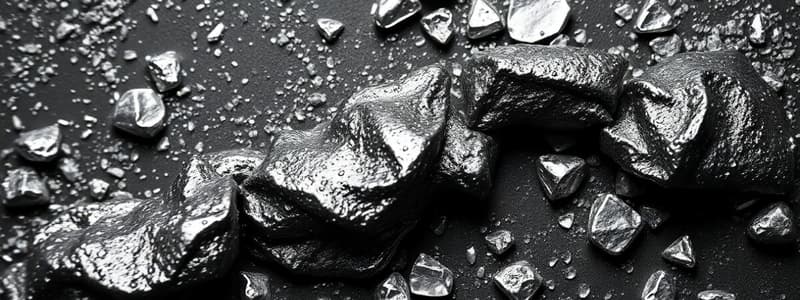Podcast
Questions and Answers
What is the most common oxidation state of silver in its compounds?
What is the most common oxidation state of silver in its compounds?
- +2
- +3
- +1 (correct)
- 0
Which of the following is a common use of silver due to the light sensitivity of silver halides?
Which of the following is a common use of silver due to the light sensitivity of silver halides?
- Mirrors
- Electrical contacts
- Photography (correct)
- Jewelry
What is the name of the condition caused by exposure to high levels of silver, which results in the skin turning bluish-gray?
What is the name of the condition caused by exposure to high levels of silver, which results in the skin turning bluish-gray?
- Argyria (correct)
- Anemia
- Melanism
- Cyanosis
Which of the following is a common use of silver due to its high electrical conductivity?
Which of the following is a common use of silver due to its high electrical conductivity?
What is the chemical formula for silver oxide?
What is the chemical formula for silver oxide?
What is the chemical symbol for silver?
What is the chemical symbol for silver?
What is the atomic number of silver?
What is the atomic number of silver?
Which property is silver known for?
Which property is silver known for?
In what form is native silver found?
In what form is native silver found?
What is a common use for silver beyond currency?
What is a common use for silver beyond currency?
Which of the following is a main silver ore?
Which of the following is a main silver ore?
What causes silver to tarnish?
What causes silver to tarnish?
What is the approximate melting point of silver?
What is the approximate melting point of silver?
Flashcards
Silver's Oxidation State
Silver's Oxidation State
The common oxidation state of silver in most compounds.
Stable Silver Isotopes
Stable Silver Isotopes
Two stable, non-radioactive forms of silver.
Silver Halides
Silver Halides
Silver compounds sensitive to light, used in the past for photography.
Silver Nitrate (AgNO3)
Silver Nitrate (AgNO3)
Signup and view all the flashcards
Argyria
Argyria
Signup and view all the flashcards
What is Ag?
What is Ag?
Signup and view all the flashcards
What is Silver?
What is Silver?
Signup and view all the flashcards
How does Silver occur?
How does Silver occur?
Signup and view all the flashcards
Top silver producing countries?
Top silver producing countries?
Signup and view all the flashcards
How is silver extracted?
How is silver extracted?
Signup and view all the flashcards
Physical properties of Silver?
Physical properties of Silver?
Signup and view all the flashcards
Silver's reaction with sulfur?
Silver's reaction with sulfur?
Signup and view all the flashcards
What is Silver used for?
What is Silver used for?
Signup and view all the flashcards
Study Notes
- Ag is the chemical symbol for Silver.
- Silver is a chemical element with the symbol Ag and atomic number 47.
- A soft, white, lustrous transition metal, it exhibits the highest electrical conductivity, thermal conductivity, and reflectivity of any metal.
- Silver is more ductile and malleable than gold.
- It is found in the Earth's crust as a pure, free element ("native silver"), as an alloy with gold and other metals, and in minerals such as argentite and chlorargyrite.
- Most silver is produced as a byproduct of copper, gold, lead, and zinc refining.
- Silver has long been valued as a precious metal.
- It is used in many ways beyond currency such as in solar panels, water filtration, jewelry and ornaments, high-value tableware and utensils (hence the term silverware), in electrical contacts and conductors, specialized mirrors, window coatings, in catalysis, and also used for its antimicrobial properties.
History
- Silver has been known since ancient times.
- It is mentioned in the Book of Genesis.
- Silver mines were important in many early cultures.
- Silver was used as currency in ancient Greece.
- Silver was an important trade good in the Roman Empire.
- Spain's colonization of the Americas led to a massive influx of silver into Europe.
Occurrence and Production
- Silver occurs in native form and in various ores.
- The main silver ores are argentite (Ag2S) and horn silver (AgCl).
- Silver is often found in association with other metals, such as gold, copper, and lead.
- Most silver is produced as a byproduct of mining these metals.
- Major silver-producing countries include Mexico, Peru, China, and Australia.
- Silver is extracted from ores through various methods, including smelting, leaching, and electrolysis.
Physical Properties
- Silver has a bright, white metallic luster.
- It is relatively soft and malleable.
- Silver has the highest electrical and thermal conductivity of all metals.
- It is resistant to corrosion in air and water, but tarnishes when exposed to sulfur or ozone.
- Silver has a melting point of 961.78 °C (1763.2 °F).
- Its boiling point is 2162 °C (3924 °F).
- The density of silver is 10.49 g/cm3.
Chemical Properties
- Silver is a relatively unreactive metal.
- It does not react with oxygen or water under normal conditions.
- Silver reacts with sulfur to form silver sulfide (Ag2S), which is the black tarnish that forms on silver objects.
- Silver dissolves in nitric acid and hot concentrated sulfuric acid.
- It forms a variety of compounds, including silver halides (AgCl, AgBr, AgI) and silver nitrate (AgNO3).
- Silver has an oxidation state of +1 in most of its compounds.
Isotopes
- Silver has two stable isotopes: 107Ag and 109Ag.
- 107Ag is slightly more abundant than 109Ag.
- Several radioactive isotopes of silver are known.
Compounds
- Silver forms a variety of compounds with other elements.
- Silver halides (AgCl, AgBr, AgI) are light-sensitive and used in photography.
- Silver nitrate (AgNO3) is a versatile compound used in medicine, photography, and chemical analysis.
- Silver oxide (Ag2O) is a brown or black powder used as a catalyst.
- Silver sulfide (Ag2S) is the black tarnish that forms on silver objects.
Uses
- Silver is used in a wide variety of applications.
- It is used in jewelry, silverware, and decorative objects.
- Silver is used in electrical contacts and conductors due to its high conductivity.
- It is used in mirrors and other reflective surfaces due to its high reflectivity.
- Silver is used in photography due to the light sensitivity of silver halides.
- It is used in medicine as an antiseptic and antimicrobial agent.
- Silver is used in dentistry in dental amalgams.
- It is used in batteries.
- Silver is used in solar panels
Biological Role
- Silver has no known biological role.
- However, it has antimicrobial properties and is used in some medical applications.
- Exposure to high levels of silver can cause argyria, a condition in which the skin turns bluish-gray.
Precautions
- Silver compounds can be toxic if ingested in large amounts.
- Some people are allergic to silver.
- Silver can stain skin and clothing.
- Silver nitrate is corrosive and can cause burns.
Studying That Suits You
Use AI to generate personalized quizzes and flashcards to suit your learning preferences.




